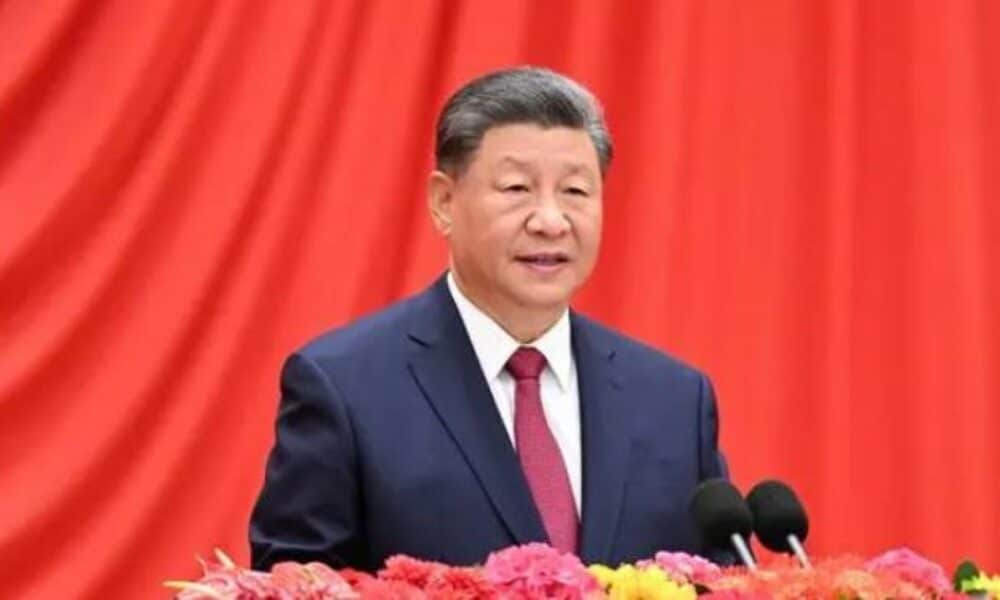China escalates retaliation against the US with 10% to 15% tariffs on American imports
The trade war between the United States and China has reached a new level as the Chinese government imposes fresh tariffs in response to measures announced by President Donald Trump. On Tuesday, February 4, 2025, Beijing confirmed the implementation of additional tariffs on American products, affecting key sectors such as energy, technology, and the automotive industry. The new tariffs, announced by China’s Ministry of Finance, will take effect on February 10. These include a 15% tax on coal and liquefied natural gas (LNG) from the US, as well as a 10% tax on crude oil, agricultural equipment, and certain automobiles. The move is seen as a direct retaliation against the 10% tariffs Trump imposed on all Chinese imports, which he justified as a measure to curb the flow of illicit drugs into the United States.
China’s response marks another chapter in the ongoing trade dispute between the two nations, which has lasted for years.
In addition to the tariffs, China has launched an antitrust investigation into Alphabet Inc., the parent company of Google, and added companies such as PVH Corp, the owner of Calvin Klein, and biotech firm Illumina to its “unreliable entity list.”
Impact of tariffs on key US sectors
The American energy sector is among the most affected by China’s new tariffs. With a 10% tax on US crude oil, there will be a direct impact on exports, which accounted for about 1.7% of China’s total oil imports last year, valued at approximately $6 billion. Additionally, tariffs on coal and LNG could harm US extraction and distribution companies, which rely on China as a major consumer market. The agricultural sector is also significantly impacted, as China is one of the largest buyers of US agricultural products. Increased tariffs on agricultural equipment may reduce the competitiveness of American companies and raise production costs in China.
US automakers, already struggling with a global slowdown in the industry, are also at the center of this dispute. Specific vehicles manufactured in the US will now face an additional 10% tariff when entering the Chinese market, potentially reducing the competitiveness of American brands such as Ford and General Motors. China, as one of the world’s largest automobile markets, is a crucial destination for US vehicle exports, and these new tariffs could directly affect automakers’ revenues.
History of the US-China trade war
The trade dispute between the United States and China began in 2018 when Trump imposed a 25% tariff on Chinese technological products worth $34 billion. Beijing responded with similar measures, taxing American goods such as vehicles and agricultural products. The conflict escalated in subsequent years, with both countries imposing new rounds of tariffs, disrupting global supply chains, and putting pressure on international markets.
Between 2018 and 2020, the US expanded its tariffs to include consumer goods, industrial equipment, and electronic components. In response, China placed restrictions on American imports and strengthened trade ties with other countries to diversify its supply chains. The trade war created uncertainty in financial markets, causing fluctuations in the stock prices of companies directly affected by the dispute.
Market reaction and future uncertainties
The announcement of new tariffs triggered immediate reactions in financial markets. The Dow Jones index opened lower, reflecting investor concerns over the escalating trade war. Companies in the energy, technology, and agriculture sectors suffered the biggest losses in market value. Economic analysts warn that reciprocal tariffs between the two countries could prolong global instability, affect investor confidence, and slow economic growth.
China’s response indicates that trade tensions between the two nations are far from being resolved. While Trump maintains his aggressive stance, reinforcing the possibility of additional tariffs if Beijing fails to meet his demands, the Chinese government signals that it will continue retaliating whenever necessary. The uncertainty surrounding a potential trade agreement adds to the volatility of global markets, with consequences for strategic sectors in both countries.
Key events in the US-China trade war
- 2018: Trump imposes a 25% tariff on Chinese technological products. Beijing retaliates by taxing American vehicles and food products.
- 2019: Both sides introduce new tariffs, covering sectors such as electronics, textiles, and agriculture.
- 2020: First attempt at a trade deal, which reduces some tariffs but maintains trade tensions.
- 2022-2023: China strengthens trade relations with other countries to reduce dependence on the US.
- 2025: Trump announces new tariffs, prompting immediate retaliation from China.
Possible consequences of the new tariffs
- Increased product prices: Higher tariffs on strategic goods could lead to increased costs in both the US and China.
- Slowdown in international trade: The ongoing dispute could disrupt global markets.
- Supply chain reconfiguration: Companies may look for alternatives to avoid high tariff costs, shifting production to other countries.
- Impact on strategic industries: Sectors such as oil, automotive, and technology are among the most affected by the tariff war.
Industries and companies directly affected by the new tariffs
- Energy: US exporters of crude oil, coal, and LNG will be directly impacted by China’s new tariffs.
- Agriculture: Manufacturers of agricultural equipment will face difficulties selling their products in the Chinese market.
- Automotive: New tariffs on vehicles could reduce sales of US automakers in China.
- Technology: The antitrust investigation into Alphabet Inc. could lead to operational restrictions for the company in China.
Global impact and future outlook
The intensification of the trade war between the United States and China does not only affect the two largest economies in the world but also has consequences for countries involved in global supply chains. Multinational companies dependent on Chinese or American inputs may face operational and financial challenges. Furthermore, increased tariffs may lead to significant changes in global trade flows, as countries seek to diversify their partnerships to mitigate risks.
Meanwhile, analysts predict that Trump may introduce further tariff measures to increase pressure on Beijing. The Chinese government, in turn, continues to emphasize that it will take countermeasures whenever necessary, keeping the dispute open-ended with no clear resolution in sight.

The trade war between the United States and China has reached a new level as the Chinese government imposes fresh tariffs in response to measures announced by President Donald Trump. On Tuesday, February 4, 2025, Beijing confirmed the implementation of additional tariffs on American products, affecting key sectors such as energy, technology, and the automotive industry. The new tariffs, announced by China’s Ministry of Finance, will take effect on February 10. These include a 15% tax on coal and liquefied natural gas (LNG) from the US, as well as a 10% tax on crude oil, agricultural equipment, and certain automobiles. The move is seen as a direct retaliation against the 10% tariffs Trump imposed on all Chinese imports, which he justified as a measure to curb the flow of illicit drugs into the United States.
China’s response marks another chapter in the ongoing trade dispute between the two nations, which has lasted for years.
In addition to the tariffs, China has launched an antitrust investigation into Alphabet Inc., the parent company of Google, and added companies such as PVH Corp, the owner of Calvin Klein, and biotech firm Illumina to its “unreliable entity list.”
Impact of tariffs on key US sectors
The American energy sector is among the most affected by China’s new tariffs. With a 10% tax on US crude oil, there will be a direct impact on exports, which accounted for about 1.7% of China’s total oil imports last year, valued at approximately $6 billion. Additionally, tariffs on coal and LNG could harm US extraction and distribution companies, which rely on China as a major consumer market. The agricultural sector is also significantly impacted, as China is one of the largest buyers of US agricultural products. Increased tariffs on agricultural equipment may reduce the competitiveness of American companies and raise production costs in China.
US automakers, already struggling with a global slowdown in the industry, are also at the center of this dispute. Specific vehicles manufactured in the US will now face an additional 10% tariff when entering the Chinese market, potentially reducing the competitiveness of American brands such as Ford and General Motors. China, as one of the world’s largest automobile markets, is a crucial destination for US vehicle exports, and these new tariffs could directly affect automakers’ revenues.
History of the US-China trade war
The trade dispute between the United States and China began in 2018 when Trump imposed a 25% tariff on Chinese technological products worth $34 billion. Beijing responded with similar measures, taxing American goods such as vehicles and agricultural products. The conflict escalated in subsequent years, with both countries imposing new rounds of tariffs, disrupting global supply chains, and putting pressure on international markets.
Between 2018 and 2020, the US expanded its tariffs to include consumer goods, industrial equipment, and electronic components. In response, China placed restrictions on American imports and strengthened trade ties with other countries to diversify its supply chains. The trade war created uncertainty in financial markets, causing fluctuations in the stock prices of companies directly affected by the dispute.
Market reaction and future uncertainties
The announcement of new tariffs triggered immediate reactions in financial markets. The Dow Jones index opened lower, reflecting investor concerns over the escalating trade war. Companies in the energy, technology, and agriculture sectors suffered the biggest losses in market value. Economic analysts warn that reciprocal tariffs between the two countries could prolong global instability, affect investor confidence, and slow economic growth.
China’s response indicates that trade tensions between the two nations are far from being resolved. While Trump maintains his aggressive stance, reinforcing the possibility of additional tariffs if Beijing fails to meet his demands, the Chinese government signals that it will continue retaliating whenever necessary. The uncertainty surrounding a potential trade agreement adds to the volatility of global markets, with consequences for strategic sectors in both countries.
Key events in the US-China trade war
- 2018: Trump imposes a 25% tariff on Chinese technological products. Beijing retaliates by taxing American vehicles and food products.
- 2019: Both sides introduce new tariffs, covering sectors such as electronics, textiles, and agriculture.
- 2020: First attempt at a trade deal, which reduces some tariffs but maintains trade tensions.
- 2022-2023: China strengthens trade relations with other countries to reduce dependence on the US.
- 2025: Trump announces new tariffs, prompting immediate retaliation from China.
Possible consequences of the new tariffs
- Increased product prices: Higher tariffs on strategic goods could lead to increased costs in both the US and China.
- Slowdown in international trade: The ongoing dispute could disrupt global markets.
- Supply chain reconfiguration: Companies may look for alternatives to avoid high tariff costs, shifting production to other countries.
- Impact on strategic industries: Sectors such as oil, automotive, and technology are among the most affected by the tariff war.
Industries and companies directly affected by the new tariffs
- Energy: US exporters of crude oil, coal, and LNG will be directly impacted by China’s new tariffs.
- Agriculture: Manufacturers of agricultural equipment will face difficulties selling their products in the Chinese market.
- Automotive: New tariffs on vehicles could reduce sales of US automakers in China.
- Technology: The antitrust investigation into Alphabet Inc. could lead to operational restrictions for the company in China.
Global impact and future outlook
The intensification of the trade war between the United States and China does not only affect the two largest economies in the world but also has consequences for countries involved in global supply chains. Multinational companies dependent on Chinese or American inputs may face operational and financial challenges. Furthermore, increased tariffs may lead to significant changes in global trade flows, as countries seek to diversify their partnerships to mitigate risks.
Meanwhile, analysts predict that Trump may introduce further tariff measures to increase pressure on Beijing. The Chinese government, in turn, continues to emphasize that it will take countermeasures whenever necessary, keeping the dispute open-ended with no clear resolution in sight.











Post Comment